Fisher Body Number Plate - 1966
[ Preface ] | [1964 ] | [ 1965 ] | [ 1966 ] | [ 1967 ] | [ 1968 ] | [ 1969 ] | [ 1970 ] | [ 1971 ] | [ 1972 ]
[ Atlanta ] | [ Baltimore ] | [ Flint ] | [ Framingham ] | [ Fremont ] | [ Kansas City ] | [ Oshawa ]
Introduction: For quite some time I’ve had an intense interest in Fisher Body Number plates, a.k.a. trim tag, cowl tag, firewall tag, etc. for 1964 through 1972 Chevelles - hereafter referred to as ‘trim tag’ since that seems to be most common moniker for these little jewels. Their diversity, not only between the different years but between the different plants in a given year, has always fascinated me. This page deals only with 1966 Chevelle trim tags.
The third model year of the Chevelle, 1966, saw its final assembly production occur at 6 plants in the U.S. - Atlanta, Georgia - Baltimore, Maryland - Fremont, California - Flint, Michigan - Framingham, Massachusetts - and Kansas City, Missouri - plus Oshawa, Ontario in Canada.
I’ll not attempt to decode what each trim code, paint code, and where applicable, group option codes in this series represent. Click on any year's link in the navigation menu at the top of the page and choose the appropriate link on that year's home page where you’ll find links for detailed information for interior, paint, and group option codes.
All research to date indicates that each Fisher Body plant assigned body numbers in sequential order based on the particular Fisher Body style number. This means that a 2-door sedan built immediately after a Malibu convertible would not have sequential body numbers, or even close, since they are different styles. Depending on production numbers of a particular body style number throughout the model year, the above 2-door sedan and Malibu convertible would be vastly different on a given day of assembly but the next 2-door sedan or Malibu convertible would have a sequential body number for that particular style.
The Fisher Body unit number has nothing to do with the vehicle identification number (VIN) assigned by GM at final assembly and if any were to match, it’d be a coincidence.
With the exception of Fremont trim tags through at least 1A, the format of all plant's blank trim tags was the same. Fremont retained the older, 1965 style trim tag through 1A and begin using the standardized format of the other plants during 1B production. Fremont is the only U.S. final assembly plant to use a style number for L6 engine Chevelles with an odd 3rd digit in the style designation, all other U.S. plants used an even third digit in the style designation for both L6 and V8 Chevelles.
Beginning around the 1st or second week of January 1966 a single small hole was punched into the tag, generally around the lower left corner, to indicate the car was equipped with anchor locations for the optional shoulder belt.
With that, let's begin 1966.
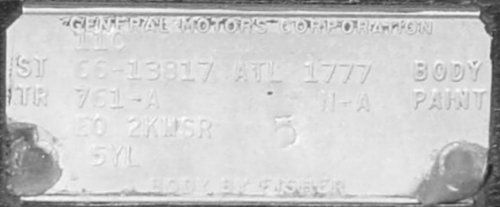
The first information line has the body assembly date consisting of the month as a 2-digit number and a single letter (A…E) designating the week. When the month is a single digit month (January through September) the month number is padded with a leading zero (0) such as 01, 02, 03, etc. This body date is embossed below the GENERAL MOTORS CORPORATION stamping. In the example 11C is the 11th month (November) and “C” represents the 3rd week.
The second information line contains the abbreviation ST (for Style) followed by the model year (66), a hyphen and the Fisher Body style number. Next is the designation for the plant location, ATL for Atlanta, and the Fisher Body unit number followed by BODY. It should be noted that the Fisher Body style number (13817 for an SS396 sport coupe in the example) has nothing to do with the GM VIN series/model designation. That means the 13817 does not indicate a V8 engine just because the third digit is an even number. Fisher Body at Atlanta did not care if the car was to receive a V8 or L6 engine. Being this example is an SS396 and no L6 SS396 was built, this would naturally be a V8 Chevelle. Generally, the Fisher Body unit number, 1777 in this case, was sequential for the particular Style number.
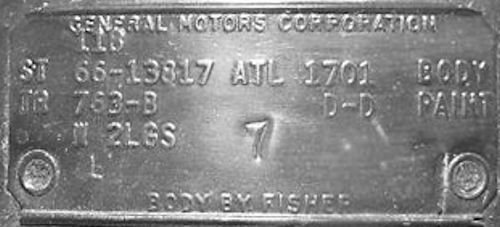
Sequence #108448
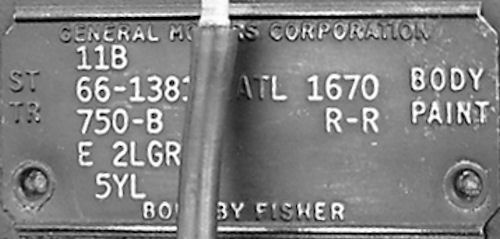
Sequence #108522
However, it was not always the case that Fisher Body style numbers followed suit with the vehicle's sequencing for the same style. Take the two examples above of SS396 sport coupes with body numbers 1701 and 1670. The VIN sequence number on the 1701 body is 108448 while the VIN sequence number on the 1670 body is 108522; the earlier body number has a later sequence number by 74 units. This can be attributed to the bodies being stored in the body bank between the Fisher Body side of the house and the final assembly side of the house and a later body number being pulled for final assembly before the earlier body number.
The third information line contains the abbreviation TR (for Trim) followed by a 3-digit number, a hyphen, and a letter indicating the seat type and color. The letter "A" indicates a bench seat, the letter "B" indicates a bucket seat, and the letter "S" indicates head rests. Next is a 2-character sequence indicating the exterior paint color with the lower body color represented by the first letter, a hyphen, and the upper body color represented by the second letter, and finally the word PAINT. When the second character is a number, it indicates a vinyl or convertible top color.
The fourth and fifth (if applicable) information line contains various letters and numbers indicating the various option groups (1 through 5) with a number for the group and letters for various options the car was ordered with within those groups. It should be noted that the first group of options does not have the number “1,” the letter “W” is in the first option group in this example. The first 3 groups are embossed on the 4th line while the 4th and 5th groups are found on the 5th line if applicable.
In the example shown, there is also a hand stamped number (5 in this example) that is believed to be a final inspector’s stamp. This 1- or 2-character hand stamped number has been found in various locations on the trim tag so it won’t always be in the same location as the example.
Through the second week of March (03B) the letter "L" appears on the sixth line of the trim tag. Sometimes by itself as shown in the top example tag and sometimes following any group 5 option codes as shown in the second example tag. This letter "L" is not a group 5 option code and its meaning is currently unknown. This mysterious "L" disappeared on Atlanta trim tags with body dates of 03C and later. Beginning around body date 01A a drilled hole began appearing at the lower left of the trim tag. This drilled hole indicated the new shoulder harness option, RPO A85, had provisions for the roof mounting points.
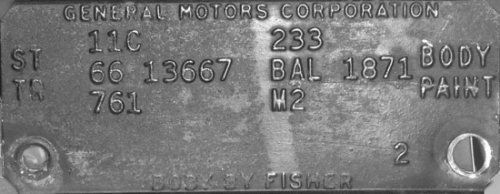
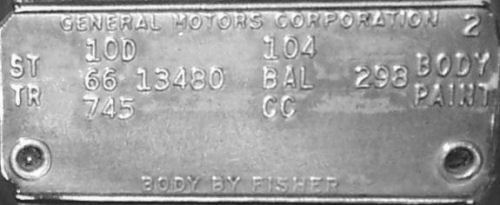
The first information line has the body assembly date consisting of the month as a 2-digit number and a single letter (A…E) designating the week. When the month is a single digit month (January through September) the month number is padded with a leading zero (0) such as 01, 02, 03, etc. Next is a 3-digit number that corresponds to the Job Number found on trim sheet for that car. Lastly, the first line (although found in other locations throughout the model year, most notably the bottom right corner as well) is a single number. It’s believed this number is for the body jig, or gate, the body was assembled on and used for quality control.
The second information line contains the abbreviation ST (for Style), followed by the model year (66) and style number. Next is the designation for the plant location, BAL for Baltimore, the Fisher Body unit number followed by BODY. It should be noted that the Fisher Body style number (13667 for a Malibu convertible or 13480 for a 300 Deluxe sedan pickup in the examples) has nothing to do with the GM VIN series/model designation. That means the 13667 or 13480 does not indicate a V8 engine just because the third digit is an even number. Fisher Body at Baltimore did not care if the car was to receive a V8 or L6 engine. Generally, the Fisher Body unit number, 1871 and 298 in these examples, was sequential for the particular STYLE number.
The third information line contains the abbreviation TR (for Trim) followed by a 3-digit number indicating the seat type and color. Note Baltimore did not use -A or -B as some other plants did to differentiate between bench and bucket seats. Next is a 2-character sequence indicating the exterior paint color with the lower body color represented by the first letter and the upper body color represented by the second letter, and finally the word PAINT. If the car has a vinyl or convertible top, the second character in the paint code is a number and designates the top's color.
The Flint assembly plant only assembled Chevelles in 1966 and 1970.


The first information line has the body assembly date consisting of the month as a 2-digit number and a single letter (A…E) designating the week. When the month is a single digit month (January through September) the month number is padded with a leading zero (0) such as 01, 02, 03, etc. This body date is embossed below the GENERAL MOTORS CORPORATION stamping. In the examples, 11E is the 11th month (November) and “E” represents the 5th week and 05D is the 5th month (May) and "D" represents the 4th week.
The second information line contains the abbreviation ST (for Style) followed by the model year (66), a hyphen and the Fisher Body style number. Next is the designation for the plant location, FL1 for Flint, and the Fisher Body unit number followed by BODY. It should be noted that the Fisher Body style number (13617 for a Malibu sport coupe or 13480 for a 300 Deluxe sedan pickup in the examples) has nothing to do with the GM VIN series/model designation. That means the 13617 or 13480 does not indicate a V8 engine just because the third digit is an even number. Fisher Body at Baltimore did not care if the car was to receive a V8 or L6 engine. Generally, the Fisher Body unit number, 1871 and 298 in these examples, was sequential for the particular STYLE number.
The third information line contains the abbreviation TR (for Trim) followed by a 3-digit number, a hyphen (except for the very early trim tags when a hyphen was not used), and a letter indicating the seat type and color. The letter "A" indicates a bench seat, the letter "B" indicates a bucket seat, and the letter "S" indicates head rests. Next is a 2-character sequence indicating the exterior paint color with the lower body color represented by the first letter, a hyphen (again, except for very early trim tags), and the upper body color represented by the second letter, and finally the word PAINT. When the second character is a number, it indicates a vinyl or convertible top color.
The fourth and fifth (if applicable) information line(s) contains various letters and numbers indicating the various option groups (1 through 5) with a number for the group and letters for various options the car was ordered with within those groups. It should be noted that the first group of options does not have the number “1,” but all other groups are preceded by the numbers "2" through "5" where applicable. At least the first 3 groups are embossed on the 4th line while the 4th and 5th groups are found on the 5th line after January 1. When no optional transmission was ordered on an SS396 and the standard heavy duty 3-speed was retained, no transmission code is shown in group 2. See last trim tag and note bucket seats and console but no optional transmission code and this car is a known manual 3-speed car.
Some time between sequence number 108059 and 108876 in December 1965 the format of the Flint trim tag changed in several ways. The exact date or sequence number of the change isn't known but the two sequence numbers above are known for certain.
1 - No hyphen character between the seat code and seat type but
rather a blank space (e.g., 763 B, 761 A, 797 S, etc.)
2 - No hyphen character between the lower and upper paint colors
(e.g., YY, DD, FF, etc.)
3 - The paint code itself is stamped directly below the plant
identification letters FL1
4 - Group options are separated by a hyphen character where
applicable and all groups are on a single line (e.g., W-2G)
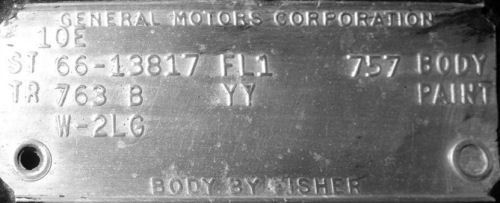



1 - Hyphen character between the seat code and seat type (e.g.,
761-A, 763-B, etc.)
2 - Hyphen character between the lower and upper paint colors (e.g.,
F-F, R-2, etc.)
3 - The paint code itself is now shown under the Fisher Body unit
number.
4 - Group options are not separated by a hyphen character but rather
a blank space and group 5 (when applicable) is on a separate line
(e.g., W 2L)

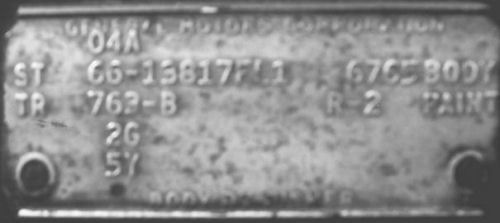
Reproduction/Fake Trim Tags
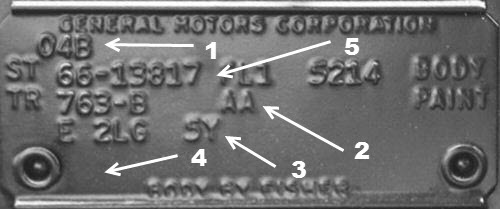
Note this reproduction trim tag for Flint.
1 - Body date of April 2nd week not aligned properly
2 - Paint code does not have hyphen character between the lower and
upper body colors and paint code in the wrong location
3 - Group 5 option code is on the wrong line.
4 - No hole in body plate indicating the car has provisions for
shoulder belts.
5 - Should not be a blank space between the Style number (13817) and
the plant identifier (FL1)
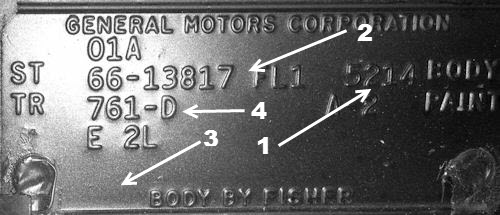
Another reproduction trim tag.
1 - Note body number 5214 is the same as the later 04B trim tag
above.
2 - Should not be a blank space between the Style number (13817) and
the plant identifier (FL1)
3 - No hole in body plate indicating the car has provisions for
shoulder belts.
4 - No such seat designation as -D.
If you're going to pay an individual or company over $200 for a reproduction tag you should at least get a reasonable facsimile.
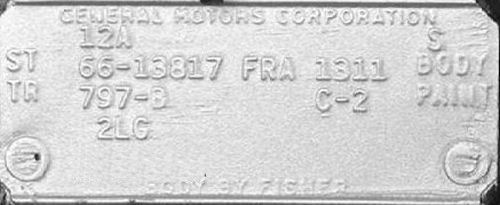
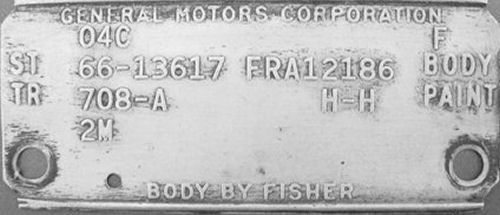
The first information line has the body assembly date consisting of the month as a 2-digit number and a single letter (A…E) designating the week. When the month is a single digit month (January through September) the month number is padded with a leading zero (0) such as 01, 02, 03, etc. This body date is embossed below the GENERAL MOTORS CORPORATION stamping. In the examples, 12A is the 12th month (December) and “A” represents the 1st week and 04C is the 4th month (April) and "C" represents the 3rd week. The single letter in the top right corner designates the interior trim paint color and corresponds to the interior trim paint color found on the warranty Protect-O-Plate.
The second information line contains the abbreviation ST (for Style) followed by the model year (66), a hyphen and the Fisher Body style number. Next is the designation for the plant location, FRA for Framingham, and the Fisher Body unit number followed by BODY. It should be noted that the Fisher Body style number (13817 for an SS396 sport coupe in the example) has nothing to do with the GM VIN series/model designation. That means the 13817 does not indicate a V8 engine just because the third digit is an even number. Fisher Body at Framingham did not care if the car was to receive a V8 or L6 engine. Being the top example is an SS396 and no L6 SS396 was built, this would naturally be a V8 Chevelle but in the case of the second tag with a style of 13617, one cannot know from the style number if the car was built with an L6 or V8 engine. Generally, the Fisher Body unit number, 1311 and 12186 in these cases, was sequential for the particular Style number.
The third information line contains the abbreviation TR (for Trim) followed by a 3-digit number, a hyphen and a letter indicating the seat type and color. The letter "A" indicates a bench seat, the letter "B" indicates a bucket seat, and the letter "S" indicates head rests. Next is a 2-character sequence indicating the exterior paint color with the lower body color represented by the first letter, a hyphen, and the upper body color represented by the second letter, and finally the word PAINT. When the second character is a number, it indicates a vinyl or convertible top color.
The fourth and fifth (if applicable) information line contains various letters and numbers indicating the various option groups (1 through 5) with a number for the group and letters for various options the car was ordered with within those groups. It should be noted that the first group of options does not have the number “1,” but all other groups are preceded by the numbers "2" through "5." The first 4 groups are embossed on the 4th line while the 5th group may be found on the 5th line.
Fremont continued to use the same trim tag format and verbiage from the 1964/1965 model year through at least part of 1B (January, 2nd week). I do have one example of a 12A 13311 trim tag in the newer format but, so far, it's unique.
The "Early" and "Late" designations are my terms and apply to the design of the trim tag itself. The data presented on both formats is essentially the same, just the layout differs.
Early Fremont
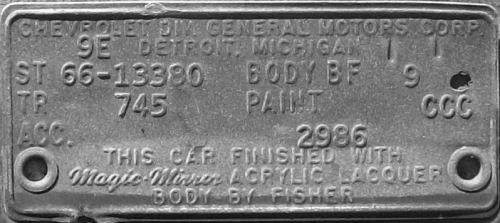

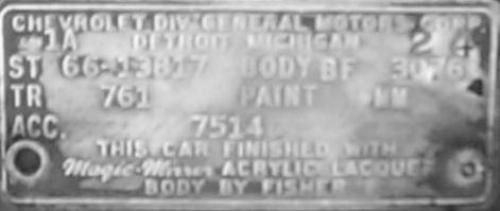
The first information line has the body assembly date consisting of the month as a 1- or 2-digit number and a single letter (A…E) designating the week. When the month is a single digit month (January through September) the month number is not padded with a leading zero (0) but simply shown as 1, 2, 3, etc. on the older format; the newer format does pad the month number with a leading zero. This body date is embossed to the left of the DETROIT, MICHIGAN stamping on the older format and below GENERAL MOTORS CORPORATION on the newer format. In the examples 9E is the 9th month (September) and “E” represents the 5th week, 11A is the 11th month (November), “A” represents the 1st week, and 1A is the 1st month (January) and "A" again represents the 1st week.
The second information line contains the abbreviation ST (for Style) followed by the model year (66), a hyphen and the Fisher Body style number. Early trim tags followed the 1965 format of the word BODY followed by designation for the plant location, BF for Fremont, and the Fisher Body unit number while the later format moved the word BODY to the end of this line.
Fremont is one of two U.S. plants to match the Fisher Body Style number to the GM series/model designation in the VIN, Flint being the second, meaning Fremont and Flint would use a style number such as 13380 to designate an L6 engine in the car where other plants would use a style number of 13480 or 13335 instead of 13435.
The third information line contains the abbreviation TR (for Trim) followed by a 3-digit number indicating the seat type and color. On early trim tags the word PAINT, then a 3-letter sequence (in most cases) indicating the exterior paint color. On early format trim tags, Fremont used a 3-character code for the exterior body paint and wheel color and other times it used a 2-character sequence without the wheel color code. The three letters indicate the lower body color, upper body color, and steel wheel paint color. Variations have also been found where some 3-character paint codes are contiguous such as CCC and some have a space between the body colors and wheel color such as LL L. On the later format trim tags, Fremont used a 2-character paint code and the word PAINT was moved to the end of the line.
The fourth information line contains the abbreviation ACC. (for accessory) and, unlike earlier years, the only ACC code found to date has been C08 indicating a vinyl top; which does not appear in the paint code. On the right side of the fourth line is a 3- to 5-character number corresponding to the manifest sequence number from production broadcast notice and this number on the trim tag may be truncated from the original number on the manifest. This manifest number has also been embossed on the far left as well as the center of this line so positioning is not consistent. The C08 vinyl top code has also been found to the right of the manifest number so positioning on that code is not consistent either.
A Fremont oddity is how convertibles were coded for paint colors. Normally a 1966 plant will use a number to indicate a convertible top color. Not Fremont; more often than not convertibles used the lower body color code for the convertible top so one does not know on these convertibles whether the convertible top is white or black. This happened on both early and late model year style trim tags. Out of 16 1966 Fremont convertibles I have trim tag data on, only three have the convertible top color coded with a number. The time frame of these three do not conform to a logical time; one is October, one is June and the third is July.
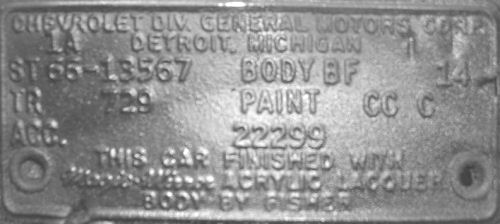

Hand stamped on the trim tag is often found a 1- or 2-digit number that is believed to be a final inspectors stamping. Whether this was done on the Fisher Body side of the house or the final assembly line is not known at this time. Typically this hand stamped number is found in the upper right corner. Also found on the early and late formatted Fremont trim tags is a jagged hole punched in the tag generally on the upper right. Whether this is a second final inspection designation or it has some other meaning entirely isn't known but it is present on the majority of 1966 Chevelle trim tags from Fremont.
Late Fremont
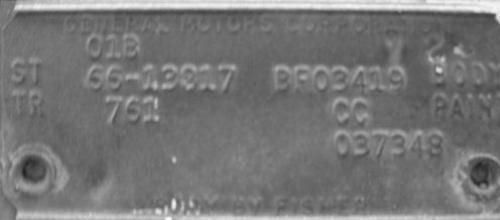
The first information line has the body assembly date consisting of the month as a 2-digit number and a single letter (A…E) designating the week. When the month is a single digit month (January through September) the month number is padded with a leading zero (0) such as 01, 02, 03, etc.
The second information line contains the abbreviation ST (for Style), followed by the model year (66), a hyphen, and style number. Next is the designation for the plant location, BF for Fremont, and the Fisher Body unit number, padded with leading zeros if necessary to display a 5-character number, followed by BODY. It should be noted that the Fisher Body style number (13817 for an SS396 sport coupe in the above example) has nothing to do with the GM VIN series/model designation. That means the 13817 does not indicate a V8 engine just because the third digit is an even number. Fisher Body did not care if the car was to receive a V8 or L6 engine. Generally, the Fisher Body unit number, 03419 in this example, was sequential for the particular STYLE number. Being this example is an SS396 and no L6 SS396 was built, this would naturally be a V8 Chevelle. Generally, the Fisher Body unit number, 03419 in this case, was sequential for the particular Style number.
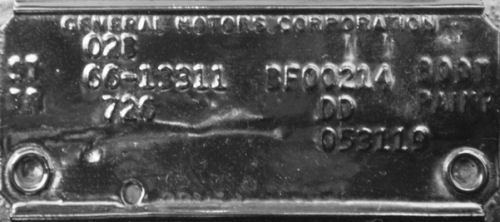
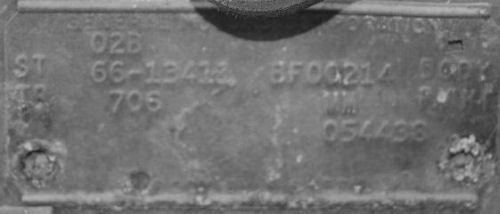
Note the same body number, 00214, on both the 13311 and 13411 300 Deluxe 2-Door Sedans indicating the production run of these two styles pretty much mirrored each other in production at least up to the 02B body dates.
The third information line contains the abbreviation TR (for Trim) followed by a 3-digit number indicating the seat type and color. Next is a 2-character sequence indicating the exterior paint color with the lower body color represented by the first letter and the upper body color represented by the second letter, and finally the word PAINT. If the Chevelle is a convertible, the top color is not shown and the 2-character paint code will contain the same two letters. However, if the Chevelle has a vinyl top, a number is shown in the 2nd position (such as H6) and C08 will appear on the fourth information line.
The fourth information line contains the C08 vinyl top code if the car is so equipped and a 6-character number that corresponds to the Body Broadcast Sheet number.
Hand stamped on the trim tag is often found a 1- or 2-digit number that is believed to be a final inspectors stamping. Whether this was done on the Fisher Body side of the house or the final assembly line is not known at this time. Typically this hand stamped number is found in the upper right corner.
Kansas City final assembly plant trim tags were fairly straightforward with 4 lines of information and consistent throughout the model year and are very similar to the Framingham trim tags.
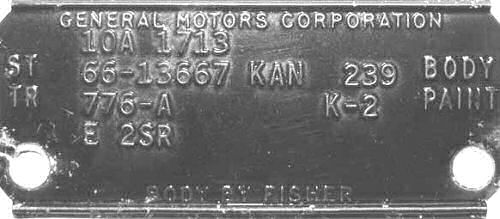

The first information line has the body assembly date consisting of the month as a 2-digit number and a single letter (A…E) designating the week. When the month is a single digit month (January through September) the month number is padded with a leading zero (0) such as 01, 02, 03, etc. This body date is embossed below the GENERAL MOTORS CORPORATION stamping. In the examples, 12A is the 12th month (December) and “A” represents the 1st week and 04C is the 4th month (April) and "C" represents the 3rd week. The 4-character number is obviously some internal plant tracking code but to date it has not turned up on any paperwork so it's significance is unknown.
The second information line contains the abbreviation ST (for Style) followed by the model year (66), a hyphen and the Fisher Body style number. Next is the designation for the plant location, KAN for Kansas City, and the Fisher Body unit number followed by BODY. It should be noted that the Fisher Body style number (13667 for a Malibu convertible in the examples) has nothing to do with the GM VIN series/model designation. That means the 13667 does not indicate a V8 engine just because the third digit is an even number. Fisher Body at Kansas City did not care if the car was to receive a V8 or L6 engine. In these cases a style of 13667, one cannot know from the style number if the car was built with an L6 or V8 engine. Generally, the Fisher Body unit number, 239 and 2870 in these cases, was sequential for the particular Style number.
The third information line contains the abbreviation TR (for Trim) followed by a 3-digit number, a hyphen, and a letter indicating the seat type and color. The letter "A" indicates a bench seat, the letter "B" indicates a bucket seat, and the letter "S" indicates head rests. Next is a 2-character sequence indicating the exterior paint color with the lower body color represented by the first letter, a hyphen, and the upper body color represented by the second letter, and finally the word PAINT. When the second character is a number, it indicates a vinyl or convertible top color.
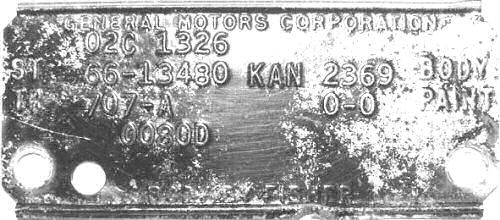
When the paint code position(s) contain a "0" in the first or both locations it indicates the car was ordered with the special paint option. The specific color is not specified by the characters but do indicate that a non-standard color was chosen for the vehicle. Other plants may have used a different method of signifying a special paint but, to date, none have turned up for 1966 Chevelles.
The fourth information line contains various letters and numbers indicating the various option groups (1 through 5) with a number for the group and letters for various options the car was ordered with within those groups. It should be noted that the first group of options does not have the number “1,” but all other groups are preceded by the numbers "2" through "5."
The Oshawa, Ontario plant Style number does indicate whether the car was to have an L6 or V8 engine.
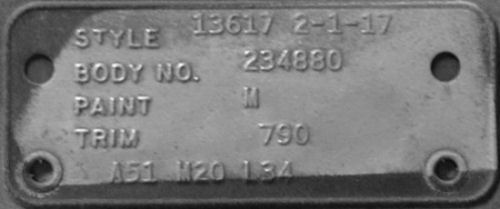

Chevelles built in Canada have trim tags vastly different from their U.S. counterpart and have 5 lines of information.
The first information line has the word STYLE followed by the particular body style designation, 13617 on the example.
Next is the assembly date; 2 is for the second shift (of 2 at the plant), a hyphen, followed by a number for the month, a hyphen, and a number for the date of the month. Since the trim tag went on the car at the start of the assembly cycle and it might take anywhere from 3 to 5 days for a car to complete the assembly process, it's assumed this date is when the car was scheduled to begin assembly, not when it finally rolled off the assembly line. Note the second tag does not have hyphen characters between the shift, month, and day. This seems to be an anomaly on this tag.
The second information line has BODY NO. followed by a 6-digit number. It's believed this body number is sequential regardless of the style. It is not known at this time what the starting number might have been.
The third information line has the word PAINT and is followed by a single letter indicating the color.
The fourth information line has the word TRIM and is followed by a 3-digit number indicating the interior trim code.
The fifth information line has any RPO option codes that might be applicable. Both of these particular Chevelles were optioned with the A51 Sports Option, M20 4-speed transmission, and L34 396/360hp engine but note the difference in the order they are listed. The 13817/67 SS396 series did not come to Canada until after January of 1967.
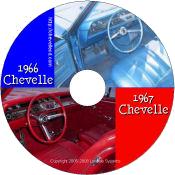
Want more in-depth information and greater analysis on 1966/1967 Chevelles? Try my 1966/1967 Chevelle
Reference CD.

 Home
Home Decode
Decode Tech
Tech Tools
Tools Dale's Coins/CDs
Dale's Coins/CDs Contact
Contact Chevelle
of the Month
Chevelle
of the Month Things
For Sale
Things
For Sale Custom
Stickers
Custom
Stickers